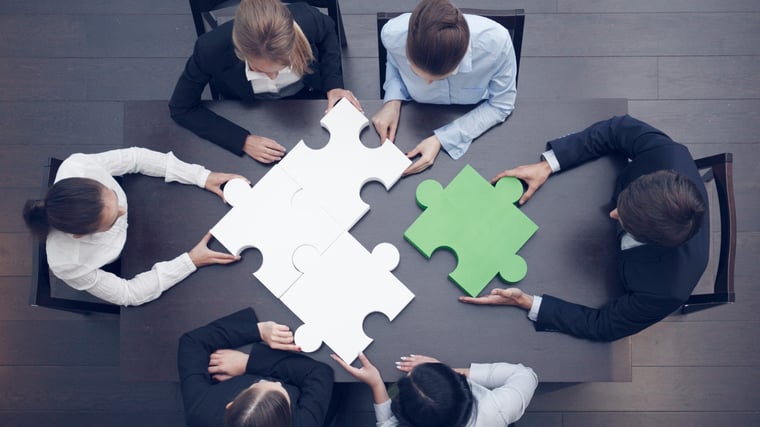In a picture book, A is for apple. But when it comes to diversity, equity, and inclusion in life and business, A is for ally, allyship, and actionable allyship.
The 3 A’s of inclusivity
The 3 A’s you need to know to build inclusivity in your workplace are:
Ally: Anyone who commits to creating cultures of inclusion and pursuing the advancement of others through positive efforts that benefit all people is an ally.
Allyship: Allyship is a lifelong process of building relationships with marginalized groups and individuals via trust, consistency, and accountability. It’s not self-determined but rather based on efforts recognized by those for whom you’re allying.
Actionable Allyship: Becoming an active ally means putting your words and intentions into practice. Allies do this by uplifting others, sharing opportunities, recognizing systemic inequalities, listening openly, and following through with self-reflection, growth, and change.
Allyship is essential for creating truly inclusive environments, but it is a title bestowed upon you, not an entitlement. You are not an ally just because your heart is in the right place. If you are looking to improve, seek feedback from those you want to ally for. Ask, “How do I show up for you?” and then listen when they respond, committing to doing the work yourself.
The 6 types of allies in the workplace
As an ally, when you want to put your intentions into action, you can have a variety of different roles. Here are a few of the ways you can be an ally according to Karen Catlin in her book, Better Allies: Everyday Actions to Create Inclusive, Engaging Workplaces:
The Sponsor
Different from a mentor, a sponsor is actively involved in the growth and progression of an underrepresented colleague or a subordinate’s career. They do so by:
- Talking up someone's abilities to boost their reputation.
- Recommending them for opportunities.
- Sharing their goals with others who can influence their success.
The Champion
A champion will publicly use their privilege to note inequities and unconscious biases. For instance, if a conference panel only has white men, a champion may pass their seat to someone from an unrepresented group. A few other examples of being a champion include:
- Directing topics or questions to others with more expertise rather than choosing to answer them yourself.
- Advocating for the inclusion of women, people of color, and other underrepresented groups in panels and as keynote speakers.
- Asking about the inclusivity efforts at conferences and other events to encourage accountability.
The Amplifier
Just like it sounds, an amplifier’s job is to crank up the volume for marginalized voices, making sure they are heard and respected. An amplifier can do that by:
- Ensuring people with good ideas get credit for them.
- Securing a code of conduct for meetings that ensures everyone feels heard while making it clear that inappropriate behavior is not accepted.
- Giving underrepresented people specific opportunities to speak in meetings.
The Advocate
An advocate uses their power, influence, and privilege to include marginalized people into otherwise exclusive circles. They can do that by:
- Reviewing invite lists of important or exclusive events and advocating to invite unrepresented people.
- Introducing marginalized colleagues to influential people.
- Collaborating with underrepresented people on projects that will elevate their standing.
The Upstander
The opposite of a bystander, an upstander is someone who sees something wrong—be it a microaggression, act of exclusion, or an act of bias—and does something to fix it. This is called conscious inclusion. Some examples include:
- Speaking up when you witness behavior that is degrading or offensive.
- Helping to keep meetings on track, especially when you notice participants questioning the expertise of a marginalized presenter or team lead.
- Acting when you notice bullying or harassment. Start by inserting yourself calmly into the conversation and following up with the victim and taking steps to address it with superiors as need be.
The Confidant
A confidant makes themselves a safe space for marginalized people to share their experiences and be listened to with an open mind and genuine care. Acting as a confidant involves:
- Believing the experiences of others even if you have never encountered something similar yourself.
- Listening and learning without taking over the conversation.
- As a manager, holding office hours in which people are encouraged to communicate their experiences and concerns openly.
When it comes to allyship, each of us needs to do our homework. We all have privileges—allies take the initiative to educate themselves about people who do not experience their same privilege and determine what they can do to improve inclusivity. In work and life, we all have roles to play. Thankfully, the great thing about allyship is that we aren't confined. Each of us can put our allyship to work as a champion, an advocate, a scholar, and more, mixing and matching and showing up wherever and whenever needed.
At Blue Ocean Brain, our mission is to help companies of all shapes and sizes build cultures of active allyship and inclusion. Our microlearning content is designed to engage everyone on the journey to diversity, equity, and inclusion by designing approachable learning that inspires true change—one bite-sized lesson at a time.



![[Guide] Why L&D is the Key to Achieving Your Company Culture Goals](https://blog.blueoceanbrain.com/hs-fs/hubfs/1283373_Images%20-%20BOB_4_012722.png?width=760&name=1283373_Images%20-%20BOB_4_012722.png)
